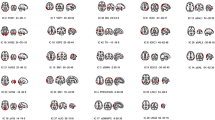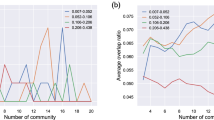Abstract
Conventional brain functional networks are constructed by extracting the entire time series from functional Magnetic Resonance Imaging (fMRI). Yet such a method is easy to ignore the dynamic interaction patterns of brain regions that essentially change across time. In this study, we analyze the functional connectivity characteristics of Rich Club in resting-state brain functional networks, and study the dynamic functional differences of core brain regions at different time periods. First, the time series is extracted from resting-state fMRI to construct a dynamic brain functional network. Then, Rich Clubs of different time periods are determined by the Rich Club coefficients. In particular, the efficiency of each Rich Club is calculated to examine the influences of the Rich Connections, Feeder Connections and Local Connections. Finally, the node degree, clustering coefficient and efficiency for Rich Club nodes are calculated to quantify the dynamic processes of Rich Clubs, and the functional connectivity of Rich Clubs are compared with those of the functional networks constructed by the entire fMRI time series. Experimental results demonstrate that the distribution of Rich Clubs in the dynamic brain functional network is consistent with that from the entire fMRI time series, while the composition and functional connectivity of Rich Club dynamically change across time. Moreover, Rich connection and Local connection in the brain functional networks show a significant correlation with the efficiency of Rich Club, and the local and the global efficiency of Rich Clubs are greater than that of the global network. These results further illustrate the viewpoint that Rich Clubs have significant influence on the functional characteristics of global brain functional networks.








Similar content being viewed by others
References
Breakspear M (2017) Dynamic models of large-scale brain activity. Nat Neurosci 20(3):340–352
Calhoun VD, Miller R, Pearlson G, Adal T (2014) The chronnectome: time-varying connectivity networks as the next frontier in fMRI data discovery. Neuron 84(2):262–274
Chen XB, Zhang H, Gao YZ, Wee CY, Li G, Shen DG (2016) High-order resting-state functional connectivity network for MCI classification. Hum Brain Mapp 37(9):3282–3296
Chen XB, Zhang H, Lee SW, Shen DG (2017) Hierarchical high-order functional connectivity networks and selective feature fusion for MCI classification. Neuroinformatics 15(3):1–14
Colizza V, Flammini A, Serrano MA, Vespignani A (2006) Detecting rich-club ordering in complex networks. Nat Phys 2(2):110–115
Daianu M, Jahanshad N, Nir TM, Jack CR Jr, Weiner MW, Bernstein MA, Thompson PM (2015) Rich club analysis in the Alzheimer's disease connectome reveals a relatively undisturbed structural core network. Hum Brain Mapp 36(8):3087–3103
Damaraju E, Allen EA, Belger A, Ford JM, McEwen S, Mathalon DH, Mueller BA, Pearlson GD, Potkin SG, Preda A, Turner JA, Vaidya JG, van Erp TG, Calhoun VD (2014) Dynamic functional connectivity analysis reveals transient states of dysconnectivity in schizophrenia. NeuroImage: Clin 5(C):298–308
Echávarri C, Aalten P, Uylings H, Jacobs H, Visser P, Gronenschild E, Verhey F, Burgmans S (2011) Atrophy in the parahippocampal gyrus as an early biomarker of Alzheimer’s disease. Brain Struct Funct 215(3–4):265–271
Geng YY, Liang RZ, Li WZ, Wang JB, Liang GY, Xu CH, Wang JY (2016) Learning convolutional neural network to maximize pos@ top performance measure. ESANN 2017 proceedings, European symposium on artificial neural networks, Computational intelligence and machine learning: 589–594
Geng YY, Zhang GH, Li WZ, Gu Y, Liang RZ, Liang GY, Wang JB, Wu YB, Patil N, Wang JY (2017) A novel image tag completion method based on convolutional neural transformation. Lect Notes Comput Sci 10614:539–546
Griffa A, Baumann PS, Thiran JP, Hagmann P (2013) Structural connectomics in brain diseases. Neuroimage 80(20):515–526
Guusje C, Kahn RS, De RMA, Wiepke C, van den Heuvel M (2014) Impaired Rich Club connectivity in unaffected siblings of schizophrenia patients. Schizophr Bull 40(2):438–448
Harrington DL, Rubinov M, Durgerian S, Mourany L, Reece C, Koenig K, Long JD, Paulsen JS (2015) Network topology and functional connectivity disturbances precede the onset of Huntington’s disease. Brain 138(8):2332–2346
Jiao ZQ, Zou L, Cao Y, Qian N, Ma ZH (2014) Effective connectivity analysis of fMRI data based on network motifs. J Supercomput 67(3):809–819
Jiao ZQ, Wang H, Ma K (2016) The connectivity measurement in complex directed networks by motif structure. Int J Sensor Netw 21(3):197–204
Jiao ZQ, Ma K, Rong YL, Wang H, Zou L (2017) Adaptive synchronization in small-world networks with Lorenz chaotic oscillators. Int J Sensor Netw 24(2):90–97
Jiao ZQ, Ma K, Wang H, Zou L, Zhang YD (2017) Research on node properties of resting-state brain functional networks by using node activity and ALFF. Multimedia Tools Appl. https://doi.org/10.1007/s11042-017-5163-2
Jiao ZQ, Wang H, Ma K, Zou L, Xiang JB (2017) Directed connectivity of brain default networks using GCA and motif. Front Biosci 22(10):1634–1643
Jiao ZQ, Ma K, Wang H, Zou L, Xiang JB (2017) Functional connectivity analysis of brain default mode networks using Hamiltonian path. CNS Neurol Disord Drug Targets 16(1):44–50
Jiao ZQ, Wang H, Ma K, Zou L, Xiang JB, Wang SH (2017) Effective connectivity in the default network using granger causal analysis. J Med Imaging Health Inform 7(2):407–415
Latora V, Marchiori M (2001) Efficient behavior of small-world networks. Phys Rev Lett 87(19):198701
Li HJ, Li HY (2016) Scalably revealing the dynamics of soft community structure in complex networks. J Syst Sci Complex 29(4):1071–1088
Ma A, Mondragón RJ (2014) Rich-cores in networks. PLoS One 10(3):e0119678
Markett S, de Reus MA, Reuter M, Montag C, Weber B, Schoene-Bake JC (2017) Serotonin and the brain's Rich Club-association between molecular genetic variation on the TPH2 gene and the structural connectome. Cereb Cortex 27(3):2166–2174
Marusak HA, Calhoun VD, Brown S, Crespo LM, Sala-Hamrick K, Gotlib IH, Thomason ME (2016) Dynamic functional connectivity of neurocognitive networks in children. Hum Brain Mapp 38(1):97–108
Mccolgan P, Seunarine KK, Razi A, Cole JH, Gregory S, Durr A, Roos RAC, Stout JC, Landwehrmeyer B, Scahill RI, Clark CA, Rees G, Tabrizi SJ (2015) Selective vulnerability of Rich Club brain regions is an organizational principle of structural connectivity loss in Huntington’s disease. Brain 138(11):3327–3344
Nguyen TT, Kovacevic S, Dev SI, Lu K, Liu TT, Eyler LT (2016) Dynamic functional connectivity in bipolar disorder is associated with executive function and processing speed: a preliminary study. Neuropsychology 31(1):73–83
Pasquale F, Penna S, Sporns O, Romani G, Corbetta M (2016) A dynamic core network and global efficiency in the resting human brain. Cereb Cortex 26(10):878–896
Poulin SP, Dautoff R, Morris JC, Barrett LF, Dickerson BC (2011) Alzheimer's disease neuroimaging initiative. Amygdala atrophy is prominent in early Alzheimer’s disease and relates to symptom severity. Psychiatry Res 194(1):7–13
Power JD, Schlaggar BL, Lessov-Schlaggar CN, Petersen SE (2013) Evidence for hubs in human functional brain networks. Neuron 79(4):798–813
Ray S, Miller M, Karalunas S, Robertson C, Grayson DS, Cary RP, Hawkey E, Painter JG, Fombonne E, Nigg JT, Fair DA (2015) Structural and functional connectivity of the human brain in autism spectrum disorders and attention-deficit/hyperactivity disorder: a rich club organization study. Hum Brain Mapp 35(12):6032–6048
Rubinov M, Sporns O (2010) Complex network measures of brain connectivity: uses and interpretations. Neuroimage 52(3):1059–1069
Sheline YI, Raichle ME (2013) Resting state functional connectivity in preclinical Alzheimer’s disease. Biol Psychiatry 74(5):340–347
Sporns O, Honey C, Kötter R (2007) Identification and classification of hubs in brain networks. PLoS One 2(10):1049–1062
Tobia MJ, Hayashi K, Ballard G, Gotlib IH, Waugh CE (2017) Dynamic functional connectivity and individual differences in emotions during social stress. Hum Brain Mapp 38(12):6185–6205
Tzourio-Mazoyer N, Landeau B, Papathanassiou D, Crivello F, Etard O, Delcroix N, Mazoyer B, Joliot M (2002) Automated anatomical labeling of activations in SPM using a macroscopic anatomical parcellation of the MNI MRI single-subject brain. NeuroImage 15(1):273–289
Van MDH, Sporns O (2011) Rich-club organization of the human connectome. J Neurosci 31(44):15775–15786
Wang JH, Zuo X, He Y (2010) Graph-based network analysis of resting-state functional MRI. Front Syst Neurosci 4(16):16
Wang X, Ren YS, Zhang WS (2017) Multi-task fused lasso metllod for constructing dynamic functional brain network of resting-state fMRI. J Image Graph 22(7):0978–0987
Wang SH, Du SD, Atangana A, Liu AJ, Lu ZY (2018) Application of stationary wavelet entropy in pathological brain detection. Multimedia Tools Appl 77(3):3701–3714
Wang SH, Phillips P, Sui Y, Liu B, Yang M, Cheng H (2018) Classification of Alzheimer's disease based on eight-layer convolutional neural network with leaky rectified linear unit and max pooling. J Med Syst 42(5):85
Wee CY, Yang S, Yap PT, Shen D (2016) Sparse temporally dynamic resting-state functional connectivity networks for early MCI identification. Brain Imaging Behav 10(2):342–356
Yang M, Zhang Y, Li JW, Zou L, Lu SY, Liu B, Yang JQ, Zhang YD (2016) Detection of left-sided and right-sided hearing loss via fractional Fourier transform. Entropy 18(5):194
Yao ZQ, Shang KK, Xu XK (2012) Fundamental statistics of weighted networks. J Univ Shanghai Sci Technol 34(1):18–26
Zhang YD, Wang SH (2015) Detection of Alzheimer's disease by displacement field and machine learning. Peerj 3(s1):e1251
Zhang YD, Dong ZC, Phillips P, Wang SH, Ji GL, Yang JQ, Yuan TF (2015) Detection of subjects and brain regions related to Alzheimer's disease using 3D MRI scans based on eigenbrain and machine learning. Front Comput Neurosci 9:66
Zhang YD, Wang SD, Phillips P, Dong ZC, Ji GL, Yang JQ (2015) Detection of Alzheimer's disease and mild cognitive impairment based on structural volumetric MR images using 3D-DWT and WTA-KSVM trained by PSOTVAC. Biomed Signal Process Control 21:58–73
Zhang YD, Chen XQ, Zhan TM, Jiao ZQ, Sun Y, Chen ZM, Yao Y, Fang LT, Lv YD, Wang SH (2016) Fractal dimension estimation for developing pathological brain detection system based on Minkowski-Bouligand method. IEEE Access 4:5937–5947
Zhang YD, Yang JQ, Yang JF, Liu AJ, Sun P (2016) A novel compressed sensing method for magnetic resonance imaging: exponential wavelet iterative shrinkage-thresholding algorithm with random shift. Int J Biomed Imaging 3:1–10
Zhang YD, Wang SH, Phillips P, Yang JQ, Yuan TF (2016) Three-dimensional eigenbrain for the detection of subjects and brain regions related with Alzheimer’s disease. J Alzheimers Dis 50(4):1163–1179
Zhang YD, Yang M, Wang SH (2017) Two-level iterative compressed sensing for cardiovascular magnetic resonance imaging. J Am Coll Cardiol 70(16):C167
Zhang GH, Liang GY, Li WZ, Fang J, Wang JB, Geng YY, Wang JY (2017) Learning convolutional ranking-score function by query preference regularization. Lect Notes Comput Sci 10585:1–8
Zhang Y, Zhang H, Chen XB, Lee SW, Shen DG (2017) Hybrid high-order functional connectivity networks using resting-state functional MRI for mild cognitive impairment diagnosis. Sci Rep 7(1):6530
Zhou S, Mondragon RJ (2003) The rich-club phenomenon in the internet topology. IEEE Commun Lett 8(3):180–182
Zhou XX, Zhang YD, Ji GL, Yang JQ, Dong ZC, Wang SH, Zhang GS, Phillips P (2016) Detection of abnormal MR brains based on wavelet entropy and feature selection. IEEJ Trans Electr Electron Eng 11(3):364–373
Acknowledgements
The authors would like to thank the reviewers and the editors for their valuable comments and suggestions on improving this paper. This work is supported by the National Natural Science Foundation of China (No. 51307010), the Natural Science Foundation of Jiangsu Province and the University Natural Science Research Program of Jiangsu Province (No. 17KJB510003).
Author information
Authors and Affiliations
Contributions
ZJ and HW conceived of the study and contributed to the manuscript. SW contributed to the resting-state functional networks analysis. YC and LZ contributed to the fMRI experimental design and analysis. All authors read and approved the final manuscript.
Corresponding authors
Ethics declarations
Conflict of interest
We have no conflicts of interest to disclose with regard to the subject matter of this paper.
Additional information
Publisher’s note
Springer Nature remains neutral with regard to jurisdictional claims in published maps and institutional affiliations.
Rights and permissions
About this article
Cite this article
Jiao, Z., Wang, H., Cai, M. et al. Rich club characteristics of dynamic brain functional networks in resting state. Multimed Tools Appl 79, 15075–15093 (2020). https://doi.org/10.1007/s11042-018-6424-4
Received:
Revised:
Accepted:
Published:
Issue Date:
DOI: https://doi.org/10.1007/s11042-018-6424-4




